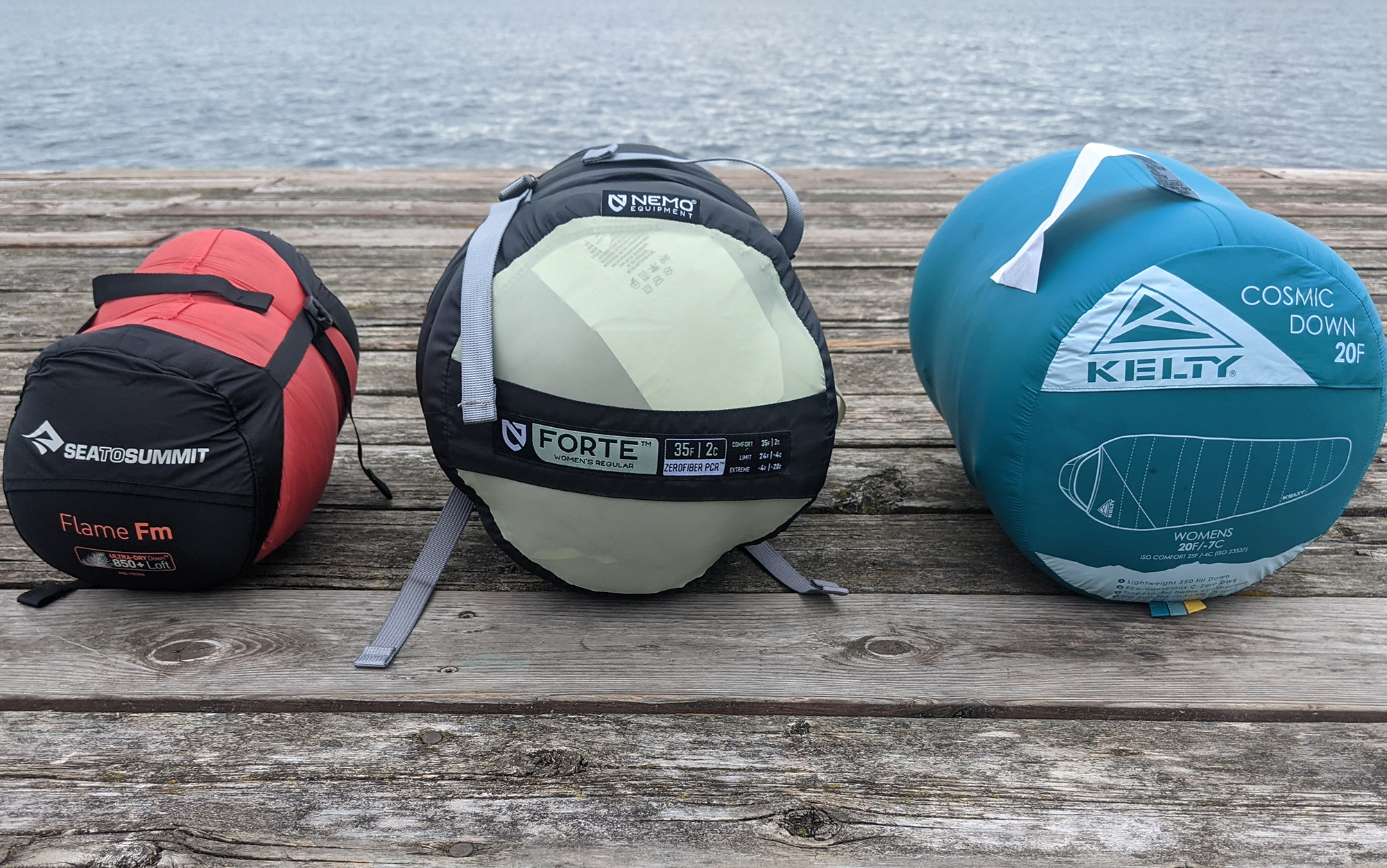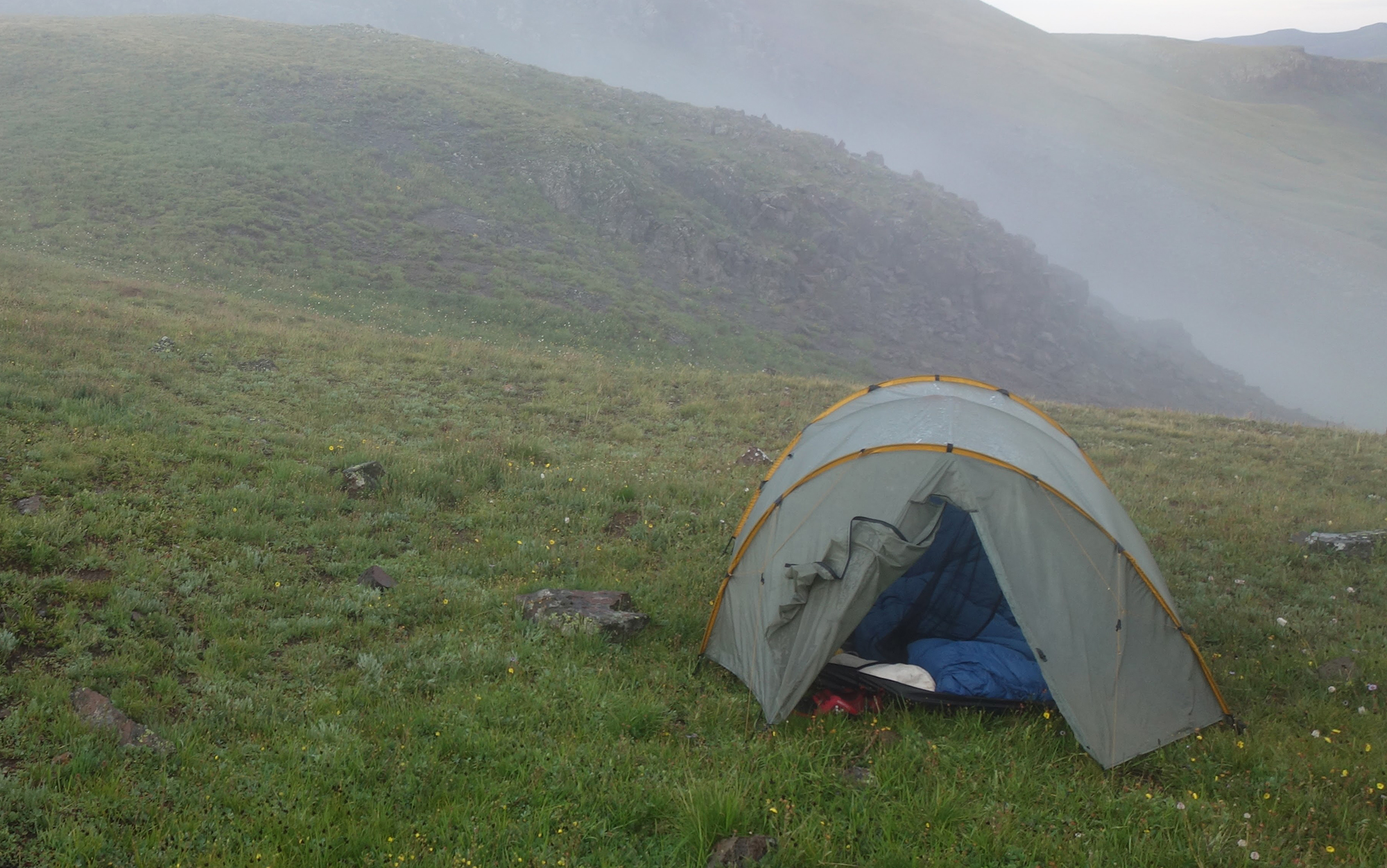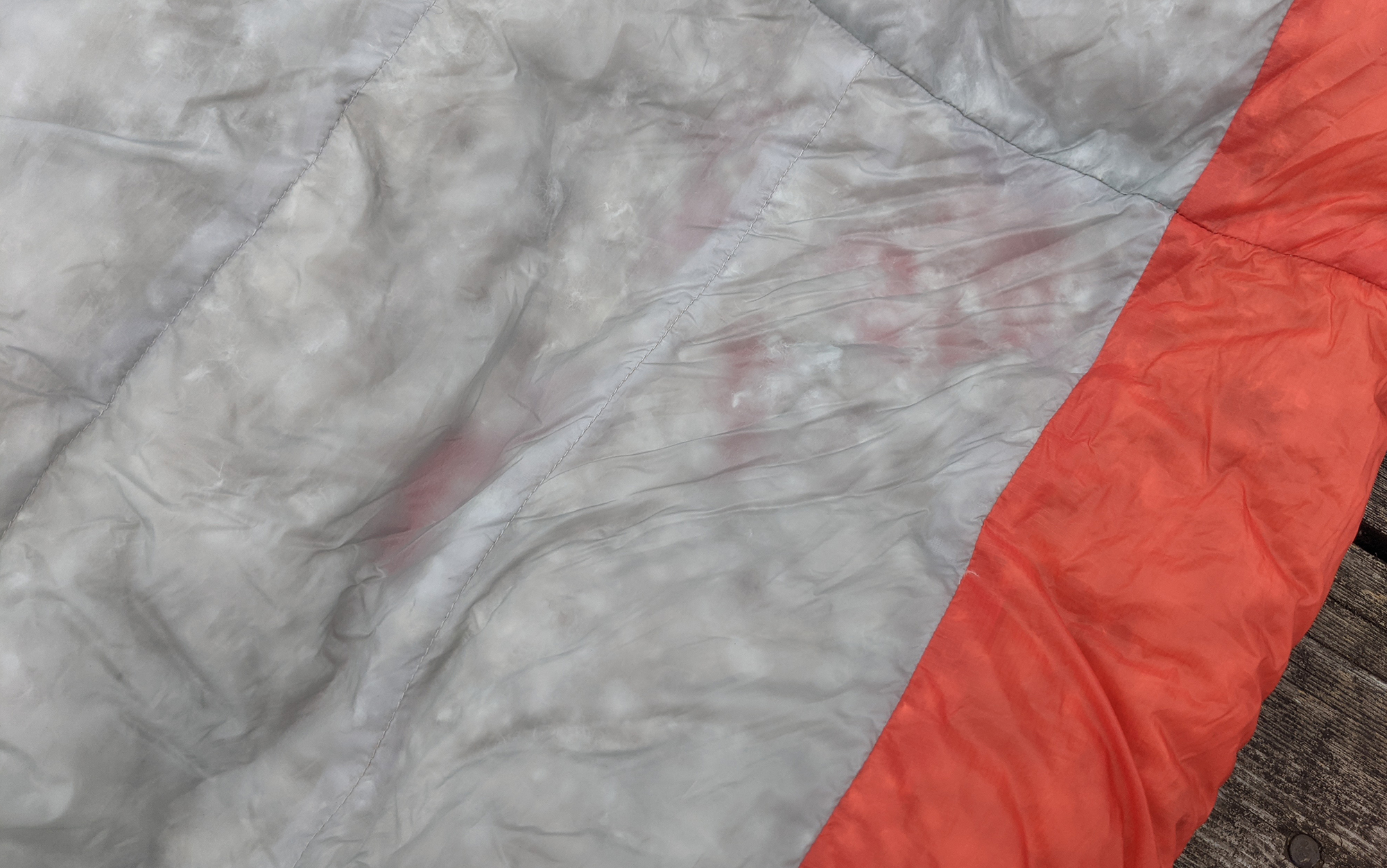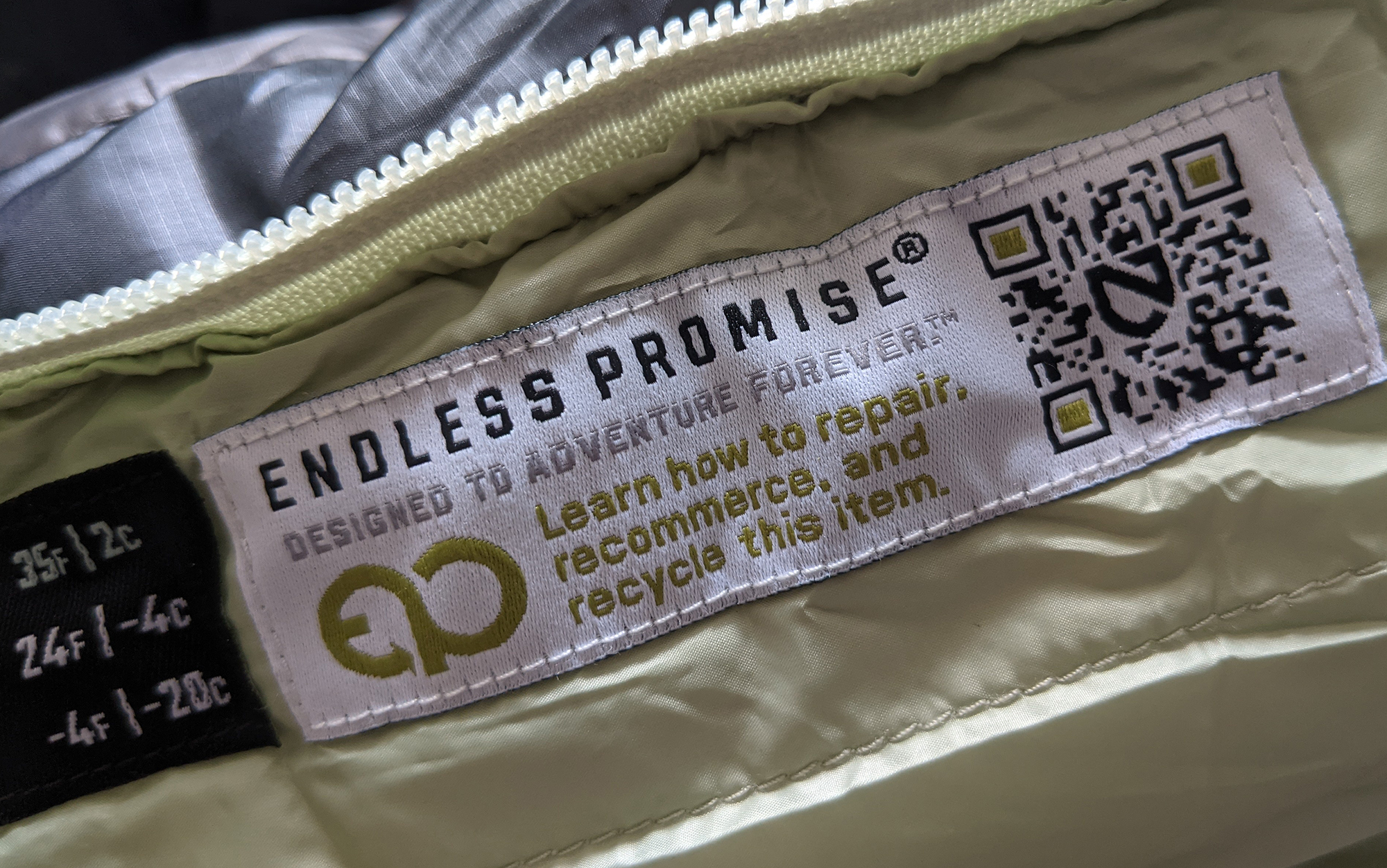We may earn revenue from the products available on this page and participate in affiliate programs. Learn More ›
If you’re new to the great debate between down vs synthetic sleeping bags, allow me to clue you in. In one corner, we have sleeping bags filled with fluffy down feathers. Their defenders say they are lightweight, space-efficient, and shockingly warm. Their detractors point out that water is down’s kryptonite: Once down gets wet, it’s essentially worthless. In the other corner is synthetic fill, where the proponents point to its affordability and reliability in all manner of conditions. But it is heavier and bulkier than down.
And then there is the environmental question: Down comes from animals (geese typically, sometimes duck), which can, in some cases, result in animal abuse. But synthetics are basically plastic, and, given the growing prevalence of microplastics in our environment, that doesn’t seem like a great choice, either.
So which should you choose? To better understand the great debate, I spoke with Heidi Allen at Nikwax and Tara Maurer at Primaloft. What I learned changed my understanding of the state of sleeping bag insulation and where it’s going in the future.
Down vs Synthetic Sleeping Bags: The Case for Down
Let’s start with what down is. These aren’t the feathers that you see when you look at a goose or duck. Down is the feathers that are underneath that waterproof outer layer, closest to the animal’s body. If you look at a down feather (keep an eye out for one poking its way through your favorite puffer jacket), you’ll see that it’s made up of innumerable wisps connected to a short shaft.
The lack of structure to these feathers creates small air pockets, which trap heat from your body and insulate it from the cold outside air. Down-feather quality is measured by fill power (fp), or how much down it takes to fill one cubic inch of space. For instance, one ounce of 550fp down will fill about 9 liters, while one ounce of 900fp will fill almost 15 liters. In sleeping bags, using down with high fill power can result in significant weight savings—an important consideration for backpackers and backpack hunters.

Down and Moisture
The Achilles heel of down feathers is moisture—when down gets wet, the pockets of air disappear, eliminating virtually all of its insulating properties. This is such an issue that Tyler Freel—Outdoor Life’s Alaska-based staff writer—won’t touch it. “I don’t take down sleeping bags sheep hunting,” he said on a recent Outdoor Life podcast. “I’ve had to crawl in my sleeping bag with all my clothes on wet too many times. And my synthetic bag will dry them out overnight.” Freel’s case might be on the extreme side, but there are plenty of people, in Alaska and in the lower 48, who won’t touch down for exactly these reasons.

In more recent years, sleeping-bag manufacturers have started applying hydrophobic treatments to down feathers to get around this. I spoke to Heidi Allen at Nikwax to learn more about how this works. “All hydrophobic down treatments are a water repellent treatment that’s been applied to the actual down feathers,” she told me. These prevent the down puffs from absorbing water. Nikwax sends their proprietary hydrophobic down treatment (what Allen called “goo”) along with instructions straight to the processor, the company that sources and grades the down. This adds a fairly negligible amount of cost to the final product compared to the varying cost of high versus low fill power down.
Read Next: Best Sleeping Bags of 2023
Down Maintenance
One point that Allen stressed when I spoke with her was the importance of maintaining your gear to maximize its performance over time. “If your sleeping bag gets super dirty, even if it’s a hydrophobic down, it’s not going to work as well as it should.” She recommends using a sleeping bag liner to help your down maintain its performance, as well as regular cleaning. “And then you can actually add a water repellent treatment at home as well,” Allen said. “Nikwax makes a waterproofing treatment for both the outer material and the feathers.”
Nikwax even put their down treatment to the ultimate test, by floating a person in a sleeping bag on lake full of glaciers in Iceland (the person stayed completely dry). But Allen still wasn’t sure she’d recommend Freel take a second look at down sleeping bags, given the way he is using them. “If you’re climbing into your sleeping bag soaking wet, and you’re lying directly on the down, then the weight of your body could cause problems by smashing water into the fill.”
Read Next: What Is R Value?
Down Sustainability
One issue with water-repellant down treatments is that many of them (although not Nikwax’s) use PFAS. PFAS is short for polyfluoroalkyl substances and, in recent years, there has been a rapidly growing understanding that having these chemicals in our environment are a detriment to human health and safety. Due to increased awareness and industry pressure (as well as new regulations in California), PFAS is likely to be phased out of hydrophobic down treatments in the coming years. However, there may be a drop-off in quality and effectiveness as a result.
A common misconception about down is that these lightweight, barely-there plumes must be exceedingly fragile—how many times can you clean them before they fall apart entirely? “Cleaning and re-waterproofing doesn’t actually hurt them unless you’re cleaning with a household detergent,” said Allen. “Household detergents are pretty harsh on down feathers and can cause them to get kind of brittle and you get more breakage from those little tiny feathers. So that’s why using a gentle down specific cleaner is really important for caring for down items.” In fact, it’s so robust that some of Nikwax’s hydrophobic down is actually made using recycled down, from things like down bed comforters and pillows.
That’s one issue with down. Another is with how the birds themselves are treated. Nikwax, like many other producers of hydrophobic down uses only RDS-certified down. RDS stands for “Responsible Down Standard” and it’s focused on animal welfare protection. The aim is to make sure that the animals are treated humanely throughout their lifecycle and that there is no live plucking of geese (currently most down is produced as a product of the food industry). When shopping for down sleeping bags look for the RDS certification.
Read Next: Best Backpacking Sleeping Pads of 2023
Our Top Picks for Down Sleeping Bags
If you’re looking to make the switch to down, here are our top recommendations to get you started:
Down vs Synthetic Sleeping Bags: The Case for Synthetic
Down is such a great insulator for sleeping bags that the original synthetic fills were actually designed to mimic it. Primaloft is one of those companies, who were first tasked by the U.S. army to create a synthetic fill that mimicked the properties of down but didn’t collapse when wet. (Primaloft still supplies the U.S. military with synthetic fill to this day.) Tara Maurer, senior vice president of product strategy, explained that Primaloft’s synthetic insulation excelled at that. It’s made of polyester, which is hydrophobic, and that the size of the fibers (very small) means that they create surface tension when they are meshed together, keeping water at bay.
So, unlike treated down, you never have to worry about the water resistance wearing off. That can be a major help if something goes wrong with your sleep system. “Imagine a scenario where you have a synthetic sleeping bag, and it’s downpouring and it gets wet,” Maurer said. “If you shake it out or wring it out, it will regain its loft and thermal properties faster than down sleeping bags, particularly untreated down.” And when it does, it will tend to retain that homogenous coverage, rather than clumping together.
Synthetic Thermal Performance
Speaking with Maurer, it was clear that that genesis, and instinct for comparison, still looms large over the synthetic market today. For instance, Maurer explained that they dislike using fill power as a measurement of synthetic fill, because it’s more of a measurement of volume than it is of thermal performance. They prefer instead to use a test called the Gustin-Bacon. In this test, a weighted plate is placed on top of 30 grams of fill to see how well the fill resists compression.
Read Next: Best Sleeping Bags for Camping
But it’s not just the fill power measurement that consumers have come to expect from both down and their synthetic counterparts: it’s also the look. People see a marshmallowy puffer jacket, complete with sewn-in baffling, they think warmth. So some synthetic fill is designed explicitly to mimic that appearance. And that’s true for sleeping bags as well. “We’re constantly trying to achieve a balance,” says Maurer. “We want to make our products as thermally efficient as possible, to use the least amount of material to get the highest net benefit.”
What that means for consumers is that you can’t eyeball the loft of a synthetic sleeping bag and assume the same rules apply as for a down sleeping bag. In these instances, it’s best to look for established ISO ratings. These ratings are achieved using a dummy and thermometers in a temperature controlled room. Over time, synthetics may even do a better job at sticking to their ISO temperature ratings, since they won’t be as affected by errant moisture. With sleeping bags that use batting (imagine a sheet of synthetic insulation) rather than loose fill, you are further protected from any issues with cold spots. You might expect to have cold spots when loose fill settles to one spot or another of the baffling.

Synthetic Sustainability
Perhaps the most interesting thing I learned from Maurer is what synthetic insulation fill providers can do to minimize the environmental footprint. The majority of Primalofts products are made with 80 percent or more recycled fibers. “The beauty about using polyester is that it can be repurposed and reused again and again,” said Maurer. “We’re taking plastic from recycled bottles, and there’s the potential to take our garment using our insulation and repurpose it into something else when it reaches its end of life.” Nemo’s new Forte sleeping bag, the first in their new Endless Promise series, is one recent example of this. This sleeping bag can be fully recycled at end of life by following attached directions.

And when it is finally headed to the landfill, that doesn’t mean that it will stay there forever and ever, like we expect to happen with synthetic or plastic-based products. “Some of our products also have an additive to them that help them biodegrade at an accelerated rate,” Maurer said. In tests, in the amount of time it took for untreated polyester to degrade by 1 percent, the polyester treated with the biodegradable additive had degraded by 94 percent.
Read Next: How to Choose a Sleeping Bag
Our Top Picks for Synthetic Sleeping Bags
Sold on the reliability and affordability of synthetic sleeping bags? Here are two of our favorites:
FAQs
Q: Is down warmer than synthetic?
With both down and synthetic materials, the amount you use can be just as important as its raw insulating power. However, for its weight, high fill power down is still much warmer than synthetic insulations.
Q: Does down lose its warmth over time?
Over time, dirt, grime, and sweat can get inside the shell of your sleeping bag. This can inhibit down’s ability to fluff up (loft) and trap warmth. But there’s good news: By washing your down, you can revive its loft and maximize its warmth. Nikwax sells down wash that can help ensure the longevity of your down sleeping bag, and they provide helpful instructions as well. Just remember, don’t use a top-loading washer, as these can rip down sleeping bags and spill those precious feathers.
Q: Is down good for winter?
Down, whether in a puffer jacket or sleeping bag, is an excellent choice for winter, due to its excellent warmth to weight ratio. Keep in mind that not all down sleeping bags are rated for winter use. Look for a sleeping bag that has a limit rate of at least 10 degrees (lower if you sleep cold).
Q: Should you hang a synthetic sleeping bag?
Yes, hang drying your synthetic sleeping bag will extend its life.
Final Thoughts
If, like me, it’s been a minute since you considered the state of down versus synthetic sleeping bags, there’s good news and bad news. The first is that many of the seemingly intractable issues with both are being tackled head-on by the industry. Down can be water resistant. Synthetic fill can be less environmentally harmful (and it doesn’t need to be so dang thick). But there are also some pieces of the equation that remain the same. High fill power down is still unmatched by synthetic fill for its warmth to weight ratio. Synthetic fill requires less care to get the same level of performance, and it tends to be quite a bit less expensive. Which of these factors is the most important to you will affect your decision, but both are excellent options that will see you through many nights in the backcountry.
